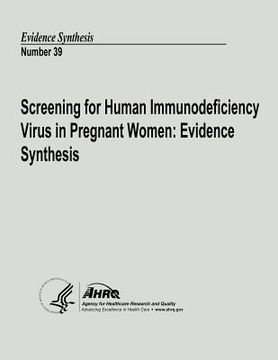Screening for Human Immunodeficiency Virus in Pregnant Women: Evidence Synthesis: Evidence Synthesis Number 39 (in English)
Synopsis "Screening for Human Immunodeficiency Virus in Pregnant Women: Evidence Synthesis: Evidence Synthesis Number 39 (in English)"
This evidence synthesis focuses on screening for unsuspected human immunodeficiency virus (HIV) using HIV antibody (Ab) tests in pregnant women, including adolescents. Since the USPSTF last published recommendations regarding HIV screening of pregnant Women, there have been substantial changes in the management of pregnant women with HIV and in the rates of mother-to-child transmission. Although this report reviews the overall body of evidence regarding screening for HIV infection in pregnant women, it focuses on more recent data regarding the efficacy of combination antiretroviral regimens in prevention of mother-to-child transmission, harms associated with receipt of antiretrovirals in pregnancy, and the accuracy and acceptability of rapid testing. There is no effective vaccine to prevent HIV infection and no cure for chronic infection. In HIV-infected pregnant women, a major goal of interventions is to reduce the risk of mother-to child transmission. Other important goals are to improve clinical outcomes in the mother, facilitate early identification of infected newborns, allow women to make informed future reproductive choices, and prevent horizontal transmission through counseling on risky behaviors. Interventions for HIV-infected pregnant women include antiretroviral therapy, avoidance of breastfeeding, specific labor and delivery management techniques such as cesarean section before labor and before rupture of membranes (elective cesarean section), prophylaxis for opportunistic infections, immunizations, counseling to reduce high-risk behaviors, and regular monitoring and follow-up. In the U.S., receipt of combination antiretrovirals in conjunction with elective cesarean section in selected women and avoidance of breastfeeding is the standard of care to reduce mother-to-child transmission of HIV. Management of HIV infection in pregnancy is a rapidly evolving area. Key Questions addressed include: KQ1. Does Screening for HIV in Asymptomatic Pregnant Women Reduce Mother-to-Child Transmission or Premature Death and Disability? KQ2. Can Clinical or Demographic Characteristics (Including Persons in Specific Settings) Identify Subgroups of Asymptomatic Pregnant Women at Increased Risk for HIV Infection Compared to the General Population of Pregnant Women? KQ3. What Are the Test Characteristics of HIV Antibody Test Strategies in Pregnant Women? KQ4. What Are the Harms (Including Labeling and Anxiety) Associated with Screening? Is Screening Acceptable to Pregnant Women? KQ5. How Many HIV-Infected Pregnant Women Who Meet Criteria for Interventions Receive Them? KQ6. What Are the Harms Associated with the Work-up for HIV Infection in Pregnant Women? KQ7a. How Effective Are Interventions (Antiretroviral Prophylaxis [to Prevent Mother-to-Child Transmission] or Treatment [to Improve Maternal Outcomes], Avoidance of Breastfeeding, Elective Cesarean Section [in Selected Patients] or Other Labor Management Practices, Counseling on Risky Behaviors, Immunizations, Routine Monitoring and Follow-up or Prophylaxis for Opportunistic Infections) in Reducing Transmission Rates or Improving Clinical Outcomes (Mortality, Functional Status, Quality of Life, Symptoms, or Opportunistic Infections) in Pregnant Women with HIV Infection? KQ7b. Does Immediate Antiretroviral Treatment in HIV-Infected Pregnant Women Result in Improvements in Clinical Outcomes Compared to Delayed Treatment until Symptomatic? KQ7c. How Well Do Interventions Reduce the Rate of Viremia, Improve CD4 Counts, and Reduce Risky Behaviors? How Does Identification of HIV Infection in Pregnant Women Affect Future Reproductive Choices? KQ8. What Are the Harms (Including Adverse Effects from In Utero Exposure) Associated with Antiretroviral Intervention and Elective Cesarean Section? KQ9. Have Improvements in Intermediate Outcomes (CD4 Counts, Viremia, or Risky Behaviors) in HIV Infected Pregnant Women Been Shown to Improve Clinical Outcomes or Reduce Mother-to-Child Transmission?

